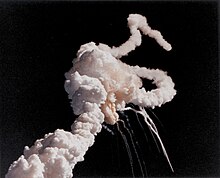Space Shuttle Challenger
Lessons learned from the first orbital flights of Columbia led to Challenger's design possessing fewer thermal protection system tiles and a lighter fuselage and wings.
On its tenth flight in January 1986, Challenger broke up 73 seconds after liftoff, killing the seven-member crew of STS-51-L that included Christa McAuliffe, who would have been the first teacher in space.
NASA's organizational culture was also scrutinized by the Rogers Commission, and the Space Shuttle program's goal of replacing the United States' expendable launch systems was cast into doubt.
The recovered remains of the orbiter are mostly buried in a missile silo located at Cape Canaveral LC-31; one piece is on display at the Kennedy Space Center Visitor Complex.
[5] STA-099 was essentially a complete airframe of a Space Shuttle orbiter, with only a mockup crew module installed and thermal insulation placed on its forward fuselage.
Major parts of STA-099, including the payload bay doors, body flap, wings, and vertical stabilizer, also had to be returned to their individual subcontractors for rework.
The mission attracted huge media attention, as one of the crew was a civilian schoolteacher, Christa McAuliffe, who was assigned to carry out live lessons from the orbiter (as part of NASA's Teacher in Space Project).
Just over a minute into the flight, a faulty booster joint opened up, leading to a flame that melted securing struts which resulted in a catastrophic structural failure and explosion of the External Tank.
[9] The collected debris of the vessel is currently buried in decommissioned missile silos at Launch Complex 31, Cape Canaveral Air Force Station.
Because of its early loss, Challenger was the only Space Shuttle that never wore the NASA "meatball" logo, and was never modified with the MEDS "glass cockpit".
In September 2020 Netflix released Challenger: The Final Flight, a four-part miniseries created by Steven Leckart and Glen Zipper documenting the tragedy firsthand.
The documents show that Morton Thiokol, which manufactured the faulty solid rocket boosters blamed for the accident, paid 60 percent, or $4,641,000.
In September 1988 a federal judge dismissed two lawsuits seeking $3 billion from Space Shuttle rocket-maker Morton Thiokol Inc. by Roger Boisjoly, a former company engineer who warned against the ill-fated 1986 Challenger launch.

















